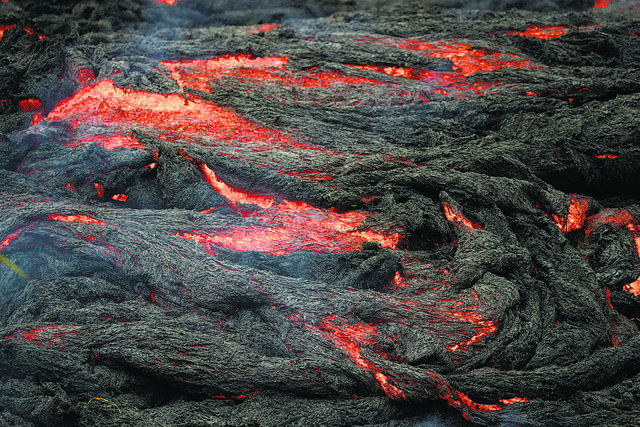Hawaii risks include slow-moving natural, man-made disasters

CINDY ELLEN RUSSELL / CRUSSELL@STARADVERTISER.COM
Lava advances in the Kapoho area of Puna.
The volcanic eruption in the Big Island’s lower Puna district is a rare natural disaster that occurs in slow motion.
With a hurricane, an earthquake, a flood, a tsunami or a fire, the damage happens in a short period of time, and those affected can immediately begin assessing their options for rebuilding or moving on.
With Hawaii’s nonexplosive volcanoes, the damage can play out over weeks, months or years as new fissures break out and lava flows advance as slowly as a few yards per hour while residents nervously wait to see if their homes will be inundated or become uninhabitable as lava covers surrounding roads and noxious fumes fill the air.
Some would argue this slow-motion disaster began more than a half-century ago, when the state and Hawaii County allowed developers to subdivide the land on Kilauea’s active east rift and homeowners began to build on the cheap-but-risky lots.
>> Hawaii risks include slow-moving natural, man-made disasters
>> #PunaStrong puts on its own show amid lava disaster
>> 7 cited for loitering in lava disaster zone in Lower Puna
>> Lava flows reignite debate over the safety and future of the Puna Geothermal Venture facility
>> Evacuation order came suddenly for Kapoho residents
>> Lava crosses Highway 137, limits access to Kapoho, Vacationland
>> Leilani Estates evacuee dies by apparent suicide
>> Big Isle mayor envisions ‘whole new community’ for Puna
>> Hawaii island resident smashes pickup into hardened lava
RELATED PHOTOS AND VIDEOS
>> Live webcams from Hawaii island
>> USGS Kilauea update on June 2, 2018
>> Maku‘u Farmer’s Market benefit concert to benefit lava victims, June 2
>> Emergency lava route through Chain of Craters-Kalapana Road nearly complete, June 1
>> Changes occurring within Halemaumau crater, June 1
>> Pyroclasts inundate Leilani Estates as lava continues to flow, May 31
>> Hawaii Army National Guard Major Jeff Hickman provides an update, May 31
>> Leilani Estates residents talk about evacuating as lava advances, May 31
>> Hawaii Fire Department tracks lava from the air, May 30
>> Aerial view of lava flow in Leilani Estates, May 29
>> No break over holiday weekend for Kilauea, May 28
Don't miss out on what's happening!
Stay in touch with breaking news, as it happens, conveniently in your email inbox. It's FREE!
COMPLETE KILAUEA COVERAGE
>> Star-Advertiser volcano coverage
>> Kilauea Volcano YouTube playlist
There’s no doubting the risks; maps of the lava flows since 1800 show that most of lower Puna between Kalapana and Kapoho has been covered by one flow or another during that time.
But those who chose to live in the inundation zone were well aware of the risk and embraced the sense of pioneering — and sometimes necessity — in taking it. They pride themselves on being tough, resilient and respectful of nature’s forces.
Over the years, lower Puna became home to a diverse population of retirees, hippies, Vietnam vets, pakalolo outlaws, off-the-gridders and local families who could afford to buy land and build a house nowhere else in Hawaii’s inflated market.
In an island state with land that is limited and expensive, most of us take risks to live here.
We build homes and businesses in flood and tsunami inundation zones and along eroding coastlines where it’s only a matter of time before the ocean claims the buildings and infrastructure.
As housing costs skyrocket, developers beckon us to live in towers of micro-apartments the size of a small garage — often at higher prices than lovely three-bedroom homes in lower Puna with beautiful yards on large lots.
In modern Hawaii, risk is a way of life, a matter of picking your poison: You can risk being overrun by lava or you can risk going crazy from claustrophobia — or worse, homelessness.
In Kakaako, speculators are buying eight-figure condos that will almost certainly face inundation from rising sea levels within a few decades. Likewise, the city is placing key stations for its $10 billion rail systems in locations where they could be swamped 25 years after opening.
Natural disasters that occur in slow motion can at least be understood and the risks reasonably calculated. It’s the slow-motion disasters made by man that are difficult to comprehend.
Reach David Shapiro at volcanicash@gmail.com.



